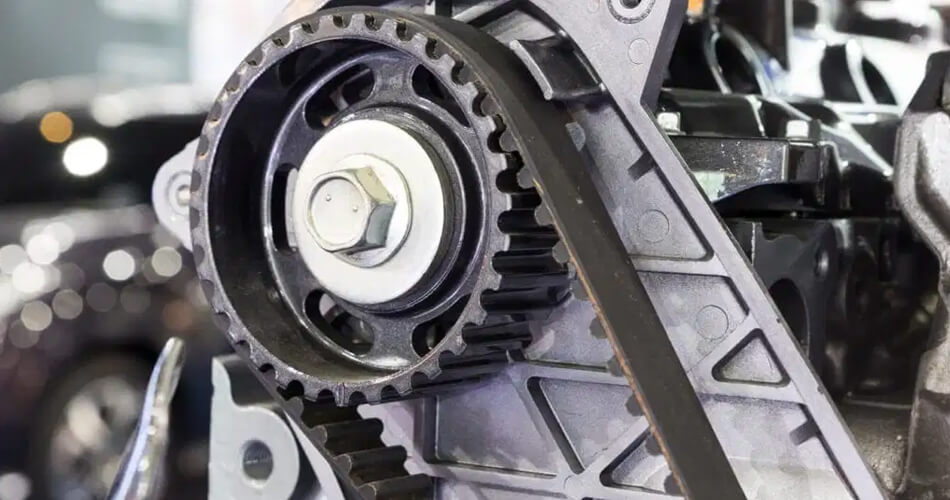One of a car’s fundamental maintenance items people often hear about is the Timing Belt (also known as a cambelt). There are many horror stories of the timing belt breaking and causing significant damage.
But many car owners who aren’t familiar with how an engine works may not know what a timing belt is, or why it’s so essential.
Contents
So what is a timing belt?
A timing belt is a reinforced rubber belt within a car’s engine that allows the engine’s valves to open and close at exactly the right time. It precisely controls the rotation of the camshaft in sync with the rotation of the crankshaft to maintain the smooth running of the engine.
So a timing belt controls the engine’s timing, but why is it so important, and what’s the difference between a timing belt and a timing chain?
What does a timing belt do?
A timing belt rotates whilst the engine is in operation to synchronise the timing of the camshaft and crankshaft. In most cars it also drives the water pump.
It allows the car’s engine to operate, and without it in one piece the engine would not start.
The video below shows how the timing belt works to control the opening and closing of the valves, and the catastrophic consequences of the timing belt snapping.
Serious damage to the engine will be caused if the belt snaps, but thankfully there are often timing belt warning signs to look out for.
What is a timing belt made of?
A timing belt is made of a reinforced rubber composite, and can include highly durable materials such as kevlar to prolong its lifespan.
Rubber does stretch and weaken over time with exposure to high operating temperatures, oil, and dirt. It’s for this reason that the timing belt is seen as a wear item, and should be replaced preventatively.
The belt also has rubber teeth to allow for a better grip of the sprockets at the end of the camshaft and crankshaft. Over time these can also be worn down, or even sheer off.
Is the timing belt part of the engine?
The timing belt is considered part of the engine. It’s attached to the exterior of the engine block rather than being inside the engine.
As a result, it’s relatively straight-forward for most car owners to check their timing belts without taking too much apart.
They are usually covered by a metal or plastic case, which would need to be removed in order to gain access.
Is the cambelt the same as the timing belt?
A timing belt IS the same as a cambelt. The two names for this part can be used interchangeably.
Many motorists are confused by the different terminology, but the simple explanation is that this component has two different names.
Is the timing belt and serpentine belt the same?
The timing belt and serpentine belt are not the same thing. The timing belt controls the timing of the engine’s valves, whereas the serpentine belt controls a variety of the car’s components, such as the power steering, alternator, and air conditioning.
Just to confuse things a little more, a serpentine belt is also known as a drive belt. It’s still essential to the smooth running of your engine, but performs a completely different job to a timing belt.
What is a timing belt tensioner?
A tensioner keeps the timing belt taut, which it needs to be in order to operate effectively.
To keep everything rotating as it should, the cambelt needs to be taut at all times. A timing belt tensioner includes:
- A spring;
- A pulley;
- An arm;
- A base.
It’s generally worth changing the timing belt tensioner at the same time as having the belt changed, as it can also wear out.
When there’s an issue with the belt tensioner, it has a knock-on effect and will lead to the timing belt itself failing.
Timing belt vs Timing chain
Timing belts and timing chains do the same job but are different in their construction and location. A timing belt is made from rubber and is located on the outside of the engine, whilst a timing chain is made of metal and located on the inside of the engine.
As we’ve established, timing belts are a wearable item that need to be changed at least once during the lifetime of a car.
On the other hand, timing chains are designed to last for the entire life of the car and will not need to be replaced in most circumstances.
The main benefit of a timing chain is that it’s made of a more durable material, but it’s also more expensive to produce and can be louder than a timing belt.
Manufacturers have done a lot of work in recent years to reduce the noise made by timing chains, and these days many manufacturers are opting for timing chains on their vehicles due to the added durability.
